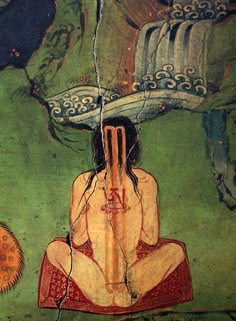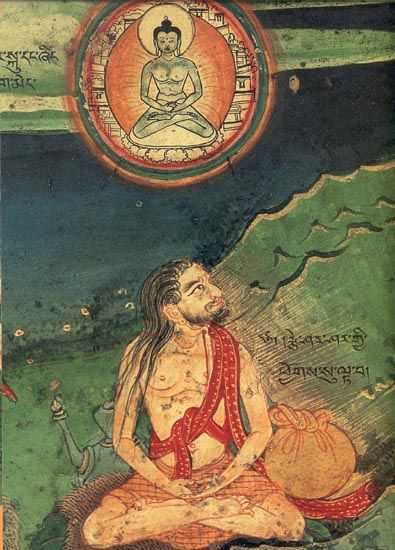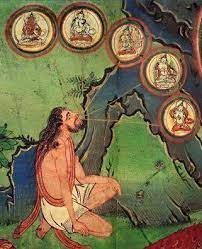1st
FORTNIGHT of FIRESTAR
As Utilized by the 5 Mt System of Miryai
In the Living Gods, Let the
hallowed Light of Transcendant Truth be praised. Let the Sweet Mystery
of Miryai awaken in the heart of hearts.
FORTNIGHT OVERVIEW



Bon - The Way of
the White Water
Spring - Fortnight 1 (Fire+Fire)
 Festival/Mar
20 (+0-15 days): The first fortnight of the Spring session is linked
to the Bonpos of Tibet. Its primitive views
of reality that once dominated this region are an asset, not a detriment.
The respect for Mt Gods, Lake Goddesses and the Nagas (Ecology), as well
as field to kitchen altar associations, albeit not scientifically valid,
are nevertheless psychologically of use in sounding the subconscious. Modern
man, divorced from nature, benefits from consciously working at reestablishing
this connection between conscious and subconscious realms. Honoring mountain
gods, lake and river goddesses, building shrines and altars in various
zones is a way to crystallize their inward and outward connectivity. The
altars being outward expressions of inward focal points or complexes, bringing
all together. Perception of mystery, of unknown unseen power - Expressing
the oneness of everything and establishing the subconscious connection
between the outer and inner world. Tantric path of alteration within Bon
and Vajrayana. Inner transmutation leading to Dzogchenian unity. Everything
outward is also in us, everything is one.
Festival/Mar
20 (+0-15 days): The first fortnight of the Spring session is linked
to the Bonpos of Tibet. Its primitive views
of reality that once dominated this region are an asset, not a detriment.
The respect for Mt Gods, Lake Goddesses and the Nagas (Ecology), as well
as field to kitchen altar associations, albeit not scientifically valid,
are nevertheless psychologically of use in sounding the subconscious. Modern
man, divorced from nature, benefits from consciously working at reestablishing
this connection between conscious and subconscious realms. Honoring mountain
gods, lake and river goddesses, building shrines and altars in various
zones is a way to crystallize their inward and outward connectivity. The
altars being outward expressions of inward focal points or complexes, bringing
all together. Perception of mystery, of unknown unseen power - Expressing
the oneness of everything and establishing the subconscious connection
between the outer and inner world. Tantric path of alteration within Bon
and Vajrayana. Inner transmutation leading to Dzogchenian unity. Everything
outward is also in us, everything is one.
Each of the 5 Seasons have 5 Fortnights, and each
Fortnight has three 5 Day "Ko". Each Ko has five segments: Mind, Body,
Truths, History, & Mythos.
First 5 Day Ko
Day 1-5 of 1st Fortnight
Mind:
Precious Human Life and Impermanence: Reflecting on the opportunity and
transience of life. Transformation: Motivates urgent practice and reduces
worldly attachment.
Body: Fire
related practices. (daily 20" exercise)
Truths: Losar
like Festival on first day.
History: Zhang Zhung,
linked to Bon’s origins (c. 500 BCE–625 CE), was a historical kingdom in
western Tibet, centered around Mount Kailash, with archaeological evidence
from sites like Kyunglung suggesting a preBuddhist culture. Practices included
fire burning rites at dawn and altars for mountain gods, lake goddesses,
and Nagas, fostering ecological reverence and innerouter unity. The unique
idea of venerating natural deities as manifestations of universal oneness
underscores its shamanic roots, predating Buddhist influence.
Mythos:
Mythos: Yeshey
Tzogyal, first female Buddha of Tibet & Padmasambhava/Shenrab Miwo.
Fortnight
1: Heavenly Descent and Early Life Divine Emanation: Yeshe Tsogyal descends
from the celestial realm as an emanation of Sarasvati, born to bring wisdom
to Tibet.
Fire related practices. (daily 20" exercise)
|
Fortnight Day 1
|
Fortnight Day 2
|
Fortnight Day 3
|
Fortnight Day 4
|
Fortnight Day 5
|
| Feast/Fast |
Losar Festival |
- |
- |
- |
- |
| Practice |
Bonfire Celebration of the new year, Fire Puja - Ritual
to offer substances to fire, symbolizing transformation. |
Tsa Lung - Breathing exercises
to ignite inner fire. |
Trul Khor - Yoga postures to
awaken energy channels. (Bön)
Trul Khor, Bön’s yogic movements, includes exercises
to activate the fire element. One practice involves dynamic circular arm
motions while visualizing a fiery wheel at the navel. Coordinate breath
with movement, inhaling to stoke the fire, exhaling to spread its heat.
This energizes the body, clears stagnation, and aligns with Bön’s
shamanistic integration of physical and energetic practices. |
Kum Nye, linked to Bön medical traditions, includes poses to awaken
energy. In a fire-focused pose, stand with feet apart, knees bent, and
arms raised like flames. Breathe deeply, visualizing heat rising from your
core, igniting vitality. Hold for a few minutes, feeling warmth spread.
This practice, rooted in Tibetan healing, boosts energy and aligns with
Bön’s elemental balance. |
Shenlha Ökar Sun Meditation (Bön)
Shenlha Ökar is a Bön deity associated with
radiant light and wisdom. In this meditation, visualize Shenlha Ökar
above you, emanating brilliant white light like the sun. As you chant his
mantra (e.g., “OM SHENLHA ÖKAR DÜ”), imagine this light entering
your crown, filling your body with warmth and clarity. This practice harnesses
the sun’s energy to dissolve ignorance and cultivate enlightened awareness,
rooted in Bön’s Dzogchen tradition. |
1. Shravaka Vehicle: Ethical Discipline and Contemplation of Impermanence
Integration: Dzogchen outer ngöndro (four thoughts: precious human
birth, impermanence, karma, suffering). Bon’s Way of Prediction (rituals
for mindfulness, e.g., offerings to cultivate awareness).
Expanded Direction: Establish a foundation of ethical conduct through
mindful living and vows (e.g., refraining from harm). Contemplate the four
thoughts daily to awaken urgency and reduce attachment to fleeting pleasures.
Use rituals to anchor mindfulness, inspired by Yeshe Tsogyal’s teachings
on life’s transience.
Practice: Adopt simple ethical precepts (e.g., non-violence, truthfulness).
Meditate on impermanence to internalize life’s fleeting nature. Perform
small rituals (e.g., lighting a candle mindfully) to reinforce awareness.
Goal: Build a moral foundation and cultivate renunciation, sparking
motivation for deeper practice.
Exercise:
Meditation: 15 minutes daily, visualize a fading
flower or reflect on death (e.g., imagine your body dissolving into dust).
Action: Perform one act of generosity daily (e.g.,
share food, donate time), inspired by Yeshe Tsogyal’s compassion.
Ritual: Offer a candle or water daily, dedicating
the merit to all beings.
State to Achieve: A visceral sense of life’s impermanence,
reduced attachment to material pursuits, and a growing urgency to practice.
Example of State: You notice less craving for distractions
(e.g., social media) and feel inspired to prioritize meditation, as if
each moment is a precious opportunity.
Outcome: Decreased worldly attachment, heightened
spiritual motivation, and a stable ethical base.
Quote: “Life is fleeting like a dew drop; seize
the moment for awakening.” – Yeshe Tsogyal (attributed, Nyingma tradition).
Second 5 Day Ko
Day 6-10 of 1st Fortnight
Mind: Karma
and Suffering of Samsara: Understanding cause-effect and cyclic suffering.
Transformation: Encourages ethical conduct and desire for liberation.
Body: Fire
related practices. (daily 20" exercise)
Truths: The
History: Old Bon,
emerging before the 7thcentury Buddhist influx, represents Tibet’s indigenous
shamanism, with texts like the Bonpo Kanjur tracing its lineage to Tonpa
Shenrab (mythically dated to 18,000 years ago, though likely 2nd century
BCE). Rituals involved oil lamps and ashes for confessions, aiming to connect
subconscious and conscious realms through purification. Its belief in all
phenomena as interconnected reflects a prescientific worldview, emphasizing
spiritual ecology.
Mythos: Yeshey
Tzogyal, first female Buddha of Tibet & Padmasambhava/Shenrab Miwo.:Fortnight
1: Heavenly Descent and Early Life Noble Birth: Born in Kharchen to a devout
family, her radiant presence marks her as extraordinary from infancy.
Fire related practices. (daily 20" exercise)
|
Fortnight Day 6
|
Fortnight Day 7
|
Fortnight Day 8
|
Fortnight Day 9
|
Fortnight Day 10
|
| Feast/Fast |
- |
- |
- |
- |
- |
| Practice |
Tsok Fire Offering |
Sun Salutations - Daily tribute to the sun for vitality. |
Offerings to the Fire Deities - Cultivating generosity and merit. |
Anger Transformation - Practices to transmute anger into wisdom. |
Chöd Practice - Cutting through ego with visualization of
self-sacrifice. |
2. Pratyekabuddha Vehicle: Insight into Interdependence
Integration: Outer ngöndro (focus on karma and interdependence).
Bon’s Way of Prediction (rituals to deepen awareness of causality).
Expanded Direction: Develop insight into dependent origination by analyzing
how phenomena arise interdependently. Use meditation to trace causes and
conditions, seeing the illusory nature of self and phenomena. Incorporate
Bon rituals to reinforce mindfulness of interconnectedness, inspired by
Yeshe Tsogyal’s wisdom on illusion.
Practice: Meditate on the chain of causes (e.g., how anger arises from
conditions). Perform rituals (e.g., burning incense mindfully) to reflect
on causality. Journal insights to clarify understanding.
Goal: Cultivate wisdom to perceive phenomena as empty and interdependent,
loosening ego-clinging.
Exercise:
Meditation: 20 minutes daily, trace an emotion (e.g.,
anger) to its causes (e.g., a past event, a thought). Observe how it lacks
inherent existence.
Journaling: Write 5 sentences daily on how an event
(e.g., a conversation) depends on multiple factors.
Ritual: Offer incense, visualizing smoke as interconnected
causes dissolving into emptiness.
State to Achieve: A clear mental shift where phenomena
feel less solid, and you perceive life as a web of causes, like ripples
in water.
Example of State: When someone criticizes you, you
see their words as arising from their own conditions (e.g., stress) rather
than as a personal attack, reducing reactivity.
Outcome: Increased clarity on causality, reduced
fixation on a solid self.
Quote: “All phenomena are empty, like reflections
in a mirror.” – Yeshe Tsogyal (attributed, Nyingma tradition).
Third 4/5 Day Ko
Day 11-15 of 1st Fortnight
Mind: Refuge
and Bodhicitta: Committing to the path and aspiring to benefit all beings.
Transformation: Establishes spiritual commitment and altruism.
Body: Fire
related practices. (daily 20" exercise)
Truths: Nyungne
2 day fast on last two days of fortnight.
History: New Bon,
formalized in the 14th century by figures like Shardza Tashi Gyaltsen,
blended Bon with Nyingma Buddhism, adopting Dzogchen and terma traditions,
though not directly tied to Naxi or Dragon Texts (a textual misassociation).
Practices like Dzogchen meditations (Trecho, Tongo) and terma revelations
focus on inner transmutation and ultimate unity. It uniquely holds that
rediscovered teachings reveal timeless truths, integrating ancient Bon
with Buddhist philosophy.
Mythos: Yeshey
Tzogyal, first female Buddha of Tibet & Padmasambhava/Shenrab Miwo.:Fortnight
1: Heavenly Descent and Early Life Spiritual Awakening: As a child, she
displays profound compassion, praying for all beings and studying Buddhist
texts.
Fire related practices. (daily 20" exercise)
|
Fortnight Day 11
|
Fortnight Day 12
|
Fortnight Day 13
|
Fortnight Day 14
|
Fortnight Day 15
|
| Feast/Fast |
- |
- |
- |
Nyungne Fast |
Nyungne Fast |
| Practice |
Oil Lamp altar Meditation
Visualization
of Inner Fire - Meditate on the inner fire at the navel. - Focus
on a flame to enhance concentration. Tummo Breath Retention Practice (Vajrayana/Nyingma)
While Tummo is shared across traditions, this Nyingma-inspired version
complements Bön’s fire focus. Sit comfortably and visualize a red-hot
seed syllable (like “RAM”) at your navel. Inhale deeply, hold the breath
gently, and imagine the fire blazing upward through the central channel,
warming your body. Exhale slowly, spreading light. This practice builds
inner heat and spiritual clarity, resonating with Bön’s elemental
work. |
Dzogchen Meditation - Dzogchen Clear Light Meditation (Bön)
Dzogchen, central to Bön, emphasizes the mind’s natural
radiance. In this meditation, sit in open awareness, imagining your mind
as a clear flame or sun-like orb at your heart. Rest in this light without
grasping, allowing thoughts to dissolve into its warmth. The practice connects
to the fire principle as the inner radiance of being, purifying distractions
and revealing the mind’s pristine nature. |
Gtum-mo - Yogic practice for generating inner heat. |
Soul Retrieval with Fire Element (Bön)
In Bön shamanism, soul retrieval (Lalu) can incorporate
the fire element to restore vitality. The practitioner enters a trance,
visualizing a fiery light that seeks out fragmented soul parts. This fire
burns away obstacles, warming and guiding the soul back to the body. Offerings
like incense or a small flame may accompany the ritual, emphasizing fire’s
role in purification and energetic reintegration. |
Chöd Fire Offering Practice (Bön)
In Bön’s Chöd practice, you mentally offer your
body as a fire offering to spiritual beings. Visualize your body transforming
into a blazing fire, radiating light and heat, which satisfies negative
forces or karmic debts. Accompany this with chanting and drum rhythms,
focusing on the fire consuming ego and attachments. This shamanistic practice
aligns with Bön’s emphasis on harmonizing with unseen energies through
fiery transformation |
3. Bodhisattva Vehicle: Generating Bodhicitta
Integration: Inner ngöndro (bodhicitta cultivation). Bon’s Way
of Virtuous Adherents (lay ethics and compassion practices).
Expanded Direction: Cultivate relative bodhicitta (aspiration to benefit
all beings) and ultimate bodhicitta (realizing emptiness for universal
liberation). Use prayers, visualizations, and compassionate actions to
align your practice with altruism, inspired by Yeshe Tsogyal’s boundless
heart.
Practice: Recite bodhicitta prayers, visualize compassion radiating
to all beings, and perform kind acts to embody altruism.
Goal: Shift motivation to universal benefit, opening the heart to all
beings.
Exercise:
Prayer: Recite the bodhicitta aspiration (“May I
attain enlightenment for all beings”) 108 times daily using a mala.
Visualization: 10 minutes daily, imagine golden
light of love radiating from your heart to a difficult person, inspired
by Yeshe Tsogyal.
Action: Perform one compassionate act daily (e.g.,
listen deeply to someone).
State to Achieve: A warm, expansive heart where
your actions naturally prioritize others’ well-being, feeling connected
to all beings.
Example of State: You feel genuine care for a stranger’s
struggles (e.g., a homeless person) and act to help without hesitation,
as if they were family.
Outcome: Open heart, altruistic motivation, reduced
self-centeredness.
Quote: “Bodhicitta is the seed of all the qualities
of buddhahood.” – Yeshe Tsogyal (attributed, Nyingma tradition).
Peace to all....
Return to Home Page
Yesai the Nazorean 2015 - All Rights
Reserved



